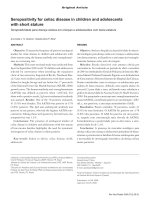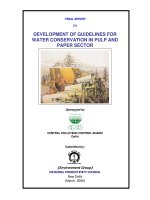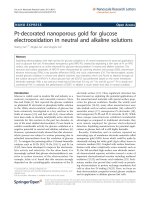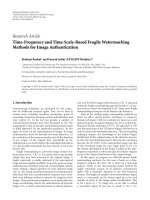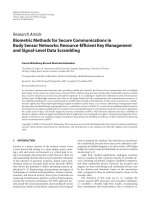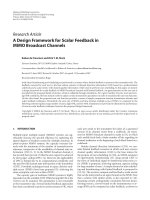ICP design methods for driven piles in sands and clays
Bạn đang xem bản rút gọn của tài liệu. Xem và tải ngay bản đầy đủ của tài liệu tại đây (704.34 KB, 13 trang )
ICP design methods
for driven piles
in sands and clays
Richard Jardine Imperial College London
Fiona Chow WorleyParsons Australia
Robert Overy Shell UK Ltd
Jamie Standing Imperial College London
Published by Thomas Telford Publishing, Thomas Telford Ltd, 1 Heron Quay, London E14 4JD.
www.thomastelford.com
Distributors for Thomas Telford books are
USA: ASCE Press, 1801 Alexander Bell Drive, Reston, VA 20191–4400, USA
Japan: Maruzen Co. Ltd, Book Department, 3–10 Nihonbashi 2-chome, Chuo-ku, Tokyo 103
Australia: DA Books and Journals, 648 Whitehorse Road, Mitcham 3132, Victoria
First published 2005
Also available from Thomas Telford Books
Deep Excavations: a practical manual, 2nd Edition, M. Puller, ISBN 0 7277 3150 5
Civil Excavations and Tunnelling: R Tatiya, ISBN 0 7277 3340 0
Designers' Guide to EN 1997-1 Eurocode 7: Geotechnical Design - general rules, Frank et al, ISBN
0 7277 1548
A catalogue record for this book is available from the British Library
ISBN: 0 7277 3272 2
© Authors and Thomas Telford 2005
All rights, including translation, reserved. Except as permitted by the Copyright, Designs and
Patents Act 1988, no part of this publication may be reproduced, stored in a retrieval system or
transmitted in any form or by any means, electronic, mechanical, photocopying or otherwise,
without the prior written permission of the Publishing Director, Thomas Telford Publishing, Thomas
Telford Ltd, 1 Heron Quay, London E14 4JD.
This book is published on the understanding that the authors are solely responsible for the
statements made and opinions expressed in it and that its publication does not necessarily imply
that such statements and/or opinions are or reflect the views or opinions of the publishers. While
every effort has been made to ensure that the statements made and the opinions expressed in this
publication provide a safe and accurate guide, no liability or responsibility for any foundation design
or other can be accepted in this respect by the authors, the organisations for which they work or
the publishers.
Printed and bound in Great Britain by Bell & Bain Ltd, Glasgow
ICP design methods for driven piles in sands and clays Page 3
CONTENTS
1 INTRODUCTION 7
2 BACKGROUND 9
2.1 Rationale for developing new design approaches 9
2.2 Imperial College research programmes 10
2.2.1 Research aims 10
2.2.2 Research phases 11
2.2.3 Field tests with instrumented piles 13
2.2.4 Parallel experiments with field-scale driven piles 13
3 DESIGN METHODS FOR PILES IN SILICA SAND 15
3.1 Introduction 15
3.2 Shaft friction 15
3.2.1 Basic mechanisms 15
3.2.2 Evaluating short-term shaft capacity of single cylindrical piles 16
3.3 Base resistance 22
3.3.1 Introduction 22
3.3.2 Closed-ended piles 22
3.3.3 Open-ended piles 23
3.4 Axial capacity of piles with non-circular cross-sections 26
3.4.1 Recommendations for rectangular piles 26
3.4.2 Recommendations for H section piles 26
4 DESIGN METHODS FOR PILES IN CLAY 28
4.1 Introduction 28
4.2 Shaft friction 28
4.2.1 Basic mechanisms 28
4.2.2 Evaluating shaft capacity of single piles after pore pressure equalisation 29
4.3 Base resistance 36
5 RELIABILITY OF THE DESIGN METHODS 38
5.1 Additional entries to the Chow pile load test database 38
5.2 Reliability of shaft capacity predictions in silica sand 42
5.2.1 Shaft capacity database for silica sand 42
5.2.2 Reliability of the ICP shaft method in sand 42
5.3 Shaft capacity in clay 46
5.3.1 Shaft capacity database for clay 46
5.3.2 Reliability of ICP shaft method in clays 46
5.4 Base resistance in sand 49
5.4.1 End bearing database in sand 49
5.4.2 Degree of fit for the ICP end bearing method in sand 50
Page 4 ICP design methods for driven piles in sands and clays
5.5
Base resistance in clay 53
5.5.1 End bearing database for clay 53
5.5.2 Degree of fit for the ICP end bearing method in clay 53
5.6 Independent analyses of ICP methods’ predictive reliability 54
5.6.1 Reliability for square and H section piles 54
5.6.2 Checks by other organisations on reliability for cylindrical driven piles 54
5.7 Selection of safety factors in design 55
5.7.1 Foundation COVs in mixed soil profiles 57
5.7.2 Reliability calibrated against well-established design methods 57
5.7.3 Reliability in terms of probability of failure 58
5.7.4 Safety Factors for the ICP methods 58
6. TIME EFFECTS IN SAND AND CLAY 61
6.1 Time effects in sand 61
6.2 Time effects in clay 64
6.3 Implications 65
7. GROUP EFFECTS IN SAND AND CLAY 66
7.1 Group effects in sand 66
7.2 Group effects in clay 66
8. EXPERIENCE WITH OTHER SOIL PROFILES 68
8.1 Micaceous sands 68
8.2 Calcareous sands 68
8.3 Silts and low plasticity clays 69
8.3.1 Assessing whether to apply clay or sand design criteria 69
8.3.2 Low plasticity, low YSR, sensitive clays and clay-silts 70
8.4 Diatomaceous clays and mudstones 71
8.5 Layered soil profiles 71
9. CYCLIC LOADING AND SEISMIC ACTION 72
9.1 General 72
9.2 Recent cyclic pile testing in sand and clay 74
9.3 Axial capacity of piles driven in clay under seismic loading 77
10. CONCLUSIONS 78
10.1 Main points 78
10.2 Check list for sands 79
10.3 Check list for clays 79
11. ACKNOWLEDGEMENTS 80
12. REFERENCES 81
APPENDIX A 87
RING SHEAR TESTING METHODOLOGY 87
ICP design methods for driven piles in sands and clays Page 5
A1.1
Principle of test 87
A1.2 Specimen and interface preparation 87
A1.3 Test procedure 88
APPENDIX B 91
CASE HISTORIES AND WORKED EXAMPLES FOR PILES IN SAND AND CLAY 91
B1 EURIPIDES 92
B1.1 Site conditions 92
B1.2 Test pile 92
B1.3 Pile capacity prediction 92
B1.4 Comparison of calculated and measured capacity 95
B2 Pentre 96
B2.1 Site conditions 96
B2.2 Test pile 99
B2.3 Pile capacity prediction 99
B2.4 Comparison of calculated and measured capacity 101
APPENDIX C 102
LIST OF NOTATION 102
ICP design methods for driven piles in sands and clays Page 7
1 INTRODUCTION
In 1996 the UK Marine Technology Directorate (MTD) published a booklet by Jardine and Chow that
summarised a new integrated approach for calculating the axial capacity of tubular piles driven in
sands and clays. Axial capacity is often the governing criterion when designing driven piles and a
simplified treatment had been developed at Imperial College London through four consecutive PhD
studies (Jardine 1985, Bond 1989, Lehane 1992 and Chow 1997). The work had been co-funded by
Industry, the UK’s Health and Safety Executive and the Engineering and Physical Science Research
Council through MTD, with the main focus being on offshore pile behaviour. The recommendations
made by Jardine and Chow relied heavily on the earlier contributions made by Bond (1989) and
Lehane (1992), testing, extending, updating and applying their work in the light of the research by
Chow (1997).
The recommendations have been applied world-wide by the Authors and others in dozens of offshore,
marine and onshore projects. Applications have ranged from major new offshore platforms (including
13 such structures commissioned and operated by Shell Exploration and Production) to large bridges
and smaller scale foundations for light industrial facilities. Offshore Engineers often refer to the
procedures as the ‘MTD’ or Imperial College Pile (ICP) design method. However, the Marine
Technology Directorate no longer operates and we suggest that the acronym ‘ICP’ is now the most
appropriate.
This second edition, published by Thomas Telford Ltd, broadens and updates the original work. New
contributions are included and we emphasise the wide range of potential civil engineering applications.
Reference is made to relevant research completed since 1996 and to lessons learned through
practice. Substantial new sections are included on choosing appropriate factors of safety, the selection
of geotechnical parameters, case histories, non-cylindrical pile shapes, ageing processes, a wider
range of soil types (including calcareous sands), group action, cyclic loading and seismic action. The
prediction of load-displacement behaviour, including the response to lateral loading, is not addressed
here. However, reference is made to other publications that describe how improved predictive
procedures have been developed from associated research at Imperial College.
Our aim is to provide:
• Descriptions of the axial capacity calculation procedures that are sufficiently detailed and clear
to allow their application by suitably qualified geotechnical engineers.
• Demonstrations of the theoretical and practical advantages offered in comparison with
conventional design methods.
• Evidence of the greater reliability and accuracy offered by the methods.
• Worked examples with references to case histories.
• Commentaries on how pile shape, age, group action, cyclic loading and seismic action can
influence field performance.
• Guidance on applying the methods to a wider range of soil types.
Page 8 ICP design methods for driven piles in sands and clays
Details of the experimental research, background theory and validation studies cannot be covered in
this deliberately short publication. Instead, a substantial list of references is provided and Appendices
are included covering (A) the methodology recommended for ring shear testing; (B) worked examples
of the ICP method’s use in sands and clays; and (C) the notation and symbols employed.
ICP design methods for driven piles in sands and clays Page 9
2 BACKGROUND
2.1 Rationale for developing new design approaches
The approaches applied by most practitioners to predict the axial capacity, Q, of displacement piles
are relatively unreliable. This may be demonstrated by comparing independent predictions, made by a
statistically meaningful group of well qualified practitioners, with data from well conducted field tests in
‘predictions competitions’, or through database analyses in which a single individual (or team) applies
a range of methods to a collection of load tests. The first approach relies on just one site, which might
not be generally representative, while the second often has to rely on incomplete information drawn
from the literature, and may be biased by the subjective judgments of the single individual or team
concerned.
Jardine et al. (2001) report a study of the first type that focused on piles driven in dense sand at the
Dunkirk research site in northern France. Full details of the site conditions and loading procedures
were published through a dedicated website. Axial capacity predictions were offered in confidence, to
an independent body, by a wide range of international consultants, researchers and specialists. Figure
1 shows the compression test capacity measured on site and the wide spread of predictions offered,
which ranged from around one third of the measured capacity to about twice this value. The calculated
capacities Q
c
fell on average around 21% below the measured value Q
m
and gave a Coefficient of
Variation (COV)
1
for (Q
c
/Q
m
) of around 0.53. Database studies by Briaud and Tucker (1988) and
Jardine and Chow (1996) show that even the best conventional approaches give COVs of a similarly
high magnitude and may also be subject to substantial bias. Despite their limitations, predictions
competitions and database studies lead to similar conclusions: predictive reliability is generally far
poorer than many practitioners recognise.
Pile load tests are specified in many projects to help mitigate the effects of predictive scatter.
However, this option is rarely available to offshore engineers and can be difficult to carry forward with
large piles in more general applications. Jardine and Chow (1996), and others since, considered how
well the procedures most commonly used by Offshore Engineers predict the capacities held in high
quality databases. They found little overall bias but report COV values as high as 0.5 to 0.7 that sit
uncomfortably with the relatively low safety margins (typically 1.5 to 2.0) that are commonly adopted
for offshore pile design. Jardine and Chow showed that the existing offshore methods are subject to
strong and systematic skewing of (Q
c
/Q
m
) with respect to factors such as pile slenderness (L/D), sand
relative density (D
r
) or clay apparent over-consolidation ratio (YSR). Existing offshore methods may be
conservative in some cases, including low L/D piles in dense sands or high YSR clays, and non-
conservative in others, such as slender piles driven in loose sands or low YSR clays.
1
The Coefficient of Variation (COV) is defined as the standard deviation, s, divided by the mean value
µ. In an ideal method µ should tend to unity and the COV to zero.
Page 10 ICP design methods for driven piles in sands and clays
0
1000
2000
3000
4000
5000
6000
36 35 32 11 17 10 15 4 13 30 7 12 31 29 5 34
Entry Number
Pile loads (kN)
Total
Measurement = 2760 kN
IC prediction = 2592 kN
Base
Shaft
Figure 1. Results from pile predictions competition based on tests in Dunkirk sand;
entries stacked in order of ascending total pile capacity estimate
Reports of piled structures experiencing difficulties due to axial capacity failures are rare. However, a
clear need exists to improve predictive methods to obtain economies, where possible, and enhance
performance, and safety, in other cases. The implementation of improved methods needs to be co-
ordinated with any parallel developments in site characterisation techniques and the specification of
loading. The latter applies particularly in cases involving high levels of environmental load, and caution
is required when working with structural arrangements that impose unusual requirements on their
foundations.
2.2 Imperial College research programmes
2.2.1 Research aims
The research carried out at Imperial College has sought to achieve: (i) a more fundamental and
thorough understanding of pile behaviour, and (ii) practical design methods that capture the basic
mechanics of driven piles as simply as possible. The main tasks were to identify:
• How piles behave in different soils and layering sequences.
• The scaling laws that relate the behaviour of models to that of full-scale piles.
• The effects on capacity of pile properties (dimensions, wall thickness, end conditions, surface
roughness, material hardness, etc.) and installation methods.
ICP design methods for driven piles in sands and clays Page 11
• Any changes in capacity and stiffness associated with time after pile installation.
• The response to different loading types, including group effects, cyclic loading and seismic
action.
• The controlling soil parameters that should be measured in site investigations.
The research reached a sufficiently developed state in 1996 for it to be applied practically. Ample
scope remained then, and now, for further discussion and research; several issues remain open to
academic discussion and potential improvement. However, as set out below, the ICP methods offer
substantially increased overall accuracy and hence tangible engineering benefits in improved reliability
and cost-effectiveness. They have also been widely applied and tested in practice since the mid
1990s.
2.2.2 Research phases
The research at Imperial College has taken place in five main phases, principally involving the sites
and profiles identified in Table 1 and Figure 2, but also supplemented by data gathered at other
locations ranging from Belfast to Mexico City.
The first phase of work involved developing the ICP instrumented piles and experimental procedures.
Multiple ICP tests and other experiments were then performed at the Building Research
Establishment’s (BRE) Canons Park test site. The research was summarised by Bond (1989) and
Bond and Jardine (1990, 1991).
Figure 2. Locations of ICP test sites in UK and France
Page 12 ICP design methods for driven piles in sands and clays
The scope was broadened in Phase 2 to cover tests in sand at the French Ponts et Chaussées’ test
site at Labenne, the BRE’s stiff till site at Cowden, and the Engineering and Physical Sciences
Research Council’s (EPSRC) former national soft clay test site at Bothkennar. At each location an
advanced site investigation was performed, a field pile testing facility established, and a programme of
multiple (closed-ended) ICP tests carried out. The Phase 2 work was reported by Lehane (1992) and
Jardine and Lehane (1994); clear and striking results emerged from the experiments that allowed new
design approaches to be proposed for closed-ended piles (Lehane et al., 1993; Lehane and Jardine,
1994a, b). The tentative proposals of Lehane and Jardine (1994c) and Lehane et al. (1994) provided
many of the key elements of the later ‘MTD’ procedures.
The third phase reported by Chow (1997) and Chow and Jardine (1996) involved:
• Establishing facilities and performing advanced site investigations and multiple ICP tests at
the Pentre (clay-silts/laminated clays) LDP research site and at the Dunkirk ‘CLAROM’ dense
sand research site.
• Interpreting and performing tests on full-scale driven open-ended piles (with diameters up to
760 mm) at the ICP sites to assess the effects of scale, installation methods and pile-end
conditions.
• Field experiments to assess pile group and ageing effects in dense sand.
• Using the above to refine the new approaches for closed-ended piles and extend the design
methods to cover open-ended driven piles.
• Collating an up-to-date and critically approved database of full-scale pile tests that met
rigorous quality criteria.
• Using the above to calibrate and validate the new methods for a wide range of practical
applications.
Phase 4 (Jardine & Standing, 2000) comprised research on full-sized piles performed at Dunkirk
between 1998 and 1999. Eight 456mm OD open-ended piles (six of which were 19m long, two 10m
long) were driven to examine the effects of cyclic loading, pile age and base grouting.
The fifth phase of relevant work at Imperial College work involved a number of smaller projects
conducted (often in collaboration with other groups) between 1997 and 2003:
• Studies by Thompson (1997) into driven pile capacity in calcareous sands and by Cowley
(1998) into the effects of pile shape on axial capacity.
• Field tests with Trinity College Dublin (TCD) on square section concrete piles driven in soft
Belfast clay to examine group action, cyclic loading and pile ageing (see Lehane and Jardine
2003 and Lehane et al., 2004).
• Field tests in collaboration with the Building Research Establishment at Canons Park to
investigate long-term pile ageing effects in clay (Pellew, 2002).
• Research into the effects of pile shape, clay type and seismic/cyclic action for piles driven in
Mexico City (Saldivar-Moguel, 2002).
• Further research into the interface shearing properties of clays and sands.
• Application of the pile design procedures to circumstances and combinations of soil conditions
that were not covered by the range of tests collated by Chow (1997), including the reuse of
pile foundations in construction projects.
ICP design methods for driven piles in sands and clays Page 13
2.2.3 Field tests with instrumented piles
A central feature of the first three phases of research has been the development of the accurate and
reliable on-pile Imperial College Pile (ICP) instrumentation to study the pore pressures, radial total
stresses, local shear stresses and temperatures developed on pile shafts. Until reliable instruments
became available, the stress conditions surrounding driven piles had been open to conjecture. The
ICP gauges were mounted on 6 to 20 m long, 102 mm diameter, closed-ended
2
steel pipe piles for
intensive testing programmes in the geotechnical profiles summarised in Table 1. The ICPs were
installed by fast jacking, allowing comprehensive measurements of the effective stress conditions
developed close to the shafts to be made at multiple levels during installation, long-term equalisation
and load testing to failure. In particular, it was possible to make direct measurements of the residual
loads set up by installation, a feature that is often hard to assess in conventional pile tests.
Detailed site investigations were performed at each site, involving in-situ tests and advanced
laboratory experiments. ‘Strain Path Method’ numerical simulations of the ICP tests performed at
Canons Park and Bothkennar were also carried out in conjunction with Professor Whittle from MIT as
described by Bond (1989) and Lehane (1992).
Table 1. Summary of Imperial College pile research sites
Site Soil conditions
1. Canons Park London Clay: stiff to very stiff, high plasticity, Eocene marine clay; high YSR
2. Cowden Cowden till: stiff to very stiff, lean, glacial lodgement till; high YSR
3. Bothkennar Carse clay: soft, high plasticity, moderately organic, Holocene shallow-
marine/estuarine clay-silt, lightly cemented: moderate YSR
4. Labenne Dune sand: loose to medium dense, medium-sized, Holocene; low YSR
5. Pentre Glacio-lacustrine clay-silt and laminated clays: very soft to firm, low plasticity, low
YSR
6. Dunkirk Marine sand: dense to very dense, shelly medium-sized sand, Flandrian: low
YSR
Note: Yield Stress Ratio (YSR) is the apparent OCR
2.2.4 Parallel experiments with field-scale driven piles
As mentioned above, less heavily instrumented open-ended driven tubular piles were driven and
tested at four of the ICP sites, providing data with which to check the potential effects on axial capacity
of pile tip detail and installation method. Offshore scale open-ended piles had been tested at Pentre as
part of the Large Diameter Pile (LDP) project described by Clarke (1993), while those at Dunkirk and
Cowden were installed for earlier projects run by the CLAROM group and BRE respectively.
2
The use of closed-ended piles allowed more accurate and robust instrumentation to be deployed.
Page 14 ICP design methods for driven piles in sands and clays
The Canons Park driven piles were installed by the Imperial College research team and the same
group worked with full-scale driven tubular piles at Dunkirk between 1998 and 1999 to study cyclic
loading, pile age and base grouting. Recent research on driven square section solid piles, performed
with Trinity College Dublin (TCD), has examined the effects of group action, cyclic loading and pile
ageing at the Kinnegar soft clay site in Belfast (see for example Lehane et al., 2004). Other projects
have investigated the effects of ageing in London Clay and pile shape, seismic action and cyclic
loading in Mexico City clay.
